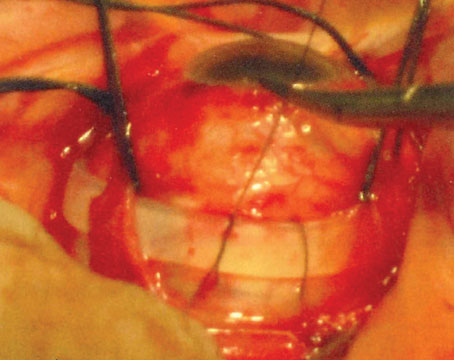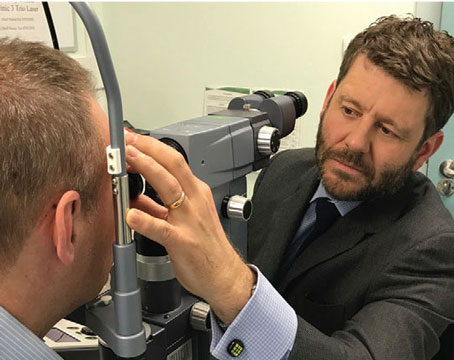 |
Surgery is a complex series of technical steps bound within an overall approach to surgery. Early in our careers, we learn those steps and approaches from mentors and hope to gather the tools to learn or create new techniques and approaches as we gain experience and advance in our careers. In this article on training vitreoretinal fellows, I took much from the mentors who trained me and much from observing the best fellows in the world over 35 years of teaching in Miami, Milwaukee and Detroit. From my mentors I learned to examine the eye (Ed Norton), develop a surgical plan (Robert Machemer) and carry out that plan (Tom Aaberg Sr. and Victor Curtin). From my fellows I have learned that there are many ways of accomplishing surgical goals and that the fellow’s ability to think and adapt both before and during a case is usually more important than his or her technical dexterity. Herein are some of the rules I teach to my vitreoretinal fellows.
1. Be a good examiner and understand the pathology of the eye.
Edward W. D. Norton, the former chair and director of the Bascom Palmer Eye Institute in Miami, was the best examiner I have ever known. He used to play a game with fellows in which he always found something on the eye examination that the fellow missed. As a fellow, I took it as a challenge and spent extra time on each of his patients to try to identify every tuft, rosette or opacity, but while my skills definitely improved, I never bested him. From him, not only did I learn how to do a complete examination, I learned the importance of a complete examination.
One of the first things I teach a fellow is to understand the eye. I want the fellow to know the vitreoretinal relationship in any surgical case. In a rhegmatogenous retinal detachment, is the vitreous completely separated? Is the vitreous base posteriorly located? Is there a PVD at all? The answers to these questions will often determine the approach to repairing the retinal detachment. For example, if the retinal detachment is due to round holes in lattice degeneration in a younger patient without a PVD, a primary vitrectomy might not be the best approach for repairing the retinal detachment and a primary scleral buckle would be the preferred operation. In vitrectomy for diabetic traction retinal detachment, the character of the vitreoretinal adhesions (focal or broad) and the degree of vitreous separation anterior to and between the vitreoretinal adhesions will determine the difficulty of dissection. The examination of the eye in conjunction with the OCT will define the best areas for beginning peeling of epiretinal membranes. I prefer the fellow make a drawing of each case and bring pertinent studies, such as OCTs, to surgery.
2. Prepare for surgery.
Following clinic, Robert Machemer would sit with the fellows and discuss each case that was to have vitrectomy. He would discuss the pertinent pathoanatomy of the eyes and the approach to surgery. As I assumed my own surgical practice, I learned that I was best prepared for a case if I preoperatively went through an exercise of thinking through the case from beginning to end. I would close my eyes and visualize the pathoanatomy of the eye and how I would do each consecutive step of the operation. I would think in detail, such as how I expected the vitreous to separate, how I would dissect and remove membranes and how I would reattach the retina and how I would perform retinopexy.
| Seeing the results of surgery and dealing with people after surgery is the best teacher! |
Besides the mental preparation for surgery, I want the fellow to prepare physically as well. The fellow should go through a checklist to make sure that everything needed for the case is available in the operating room. While a large medical center operating room may have multiples of every piece of equipment, that may not be the case everywhere. Therefore, it is the surgeon’s responsibility to make sure all needed equipment is available. It is best to do this before the patient reaches the operating room because it is difficult to cancel a case once the patient is there. In addition, the fellow must learn to understand the equipment and be able to troubleshoot problems. The surgeon can’t always depend on “others” to get balky equipment running or make sure all the tubes are correctly connected if the “others” aren’t there.
3. Learn to operate.
It is difficult to learn vitreoretinal surgery by reading about it or watching it. The small nuances of vitreoretinal surgery are such that the fellow has to do surgery in order to learn surgery. The learning should be in a well-supervised environment. After watching one case with me, I give the fellow increasing surgical responsibilities on subsequent cases. Fellows vary in the time it takes to assume major technical and decision-making responsibilities, but the majority of motivated fellows learn to do most maneuvers in vitreoretinal surgery within six to eight months. Learning good decision-making generally takes more time than learning the technical aspects of retinal surgery. Decision-making only comes with reading, discussion of cases with mentors and thinking through each case prior to surgery. Post-surgery critique by mentors is critical to developing excellent technical and decision-making skills. Possibly most important, the fellow must see and follow all of his or her postoperative patients. Seeing the results of surgery and dealing with people after surgery is the best teacher of all!
In modern vitreoretinal surgery, there are many ways to reattach retinas, peel membranes or do many different maneuvers. At the American Academy of Ophthalmology Subspecialty Day in Retina, there are often debates on surgical topics with one speaker “pro” and the other speaker “con.” Topics such as use of perfluorocarbon liquid to reattach the retina during vitrectomy vs. creation of a drainage retinotomy, placement of a scleral buckle or not when doing primary vitrectomy for retinal detachment or whether a primary scleral buckle or a primary vitrectomy is best for a certain retinal detachment show that there is usually not a single general answer for most of these controversies. However, what is apparent is that the surgeon must be well-trained in all of these techniques so he or she can give the best treatment for the individual case based on best evidence.
4. Continue to learn.
Fellowship is only a beginning. I encourage fellows to continue to discuss cases with colleagues and mentors long after completion of fellowship. In addition, soon after completion of fellowship, I encourage fellows to observe outstanding surgeons operate. Unlike when first learning vitreoretinal surgery, a trained surgeon can learn a great deal by watching other surgeons operate. When new techniques are introduced, I encourage former fellows to go to seminars, observe videos and watch other surgeons in order to learn new techniques. Within one year of completing my fellowship, because of improvements in instrumentation, I was doing many things differently.
Vitreoretinal surgery is an always-evolving specialty and we must all continue to evolve as surgeons. Going back to Crosby, Stills, Nash & Young, “ … and so become yourself because the past is just a goodbye.” Ciao. REVIEW
Dr. Abrams is a professor at the Kresge Eye Institute, Department of Ophthalmology, at Wayne State University School of Medicine. Contact Dr. Abrams at: Kresge Eye Institute, Wayne State University, 4717 St. Antoine St., Detroit, Mich. 48201. Email: gabrams@med.wayne.edu.






